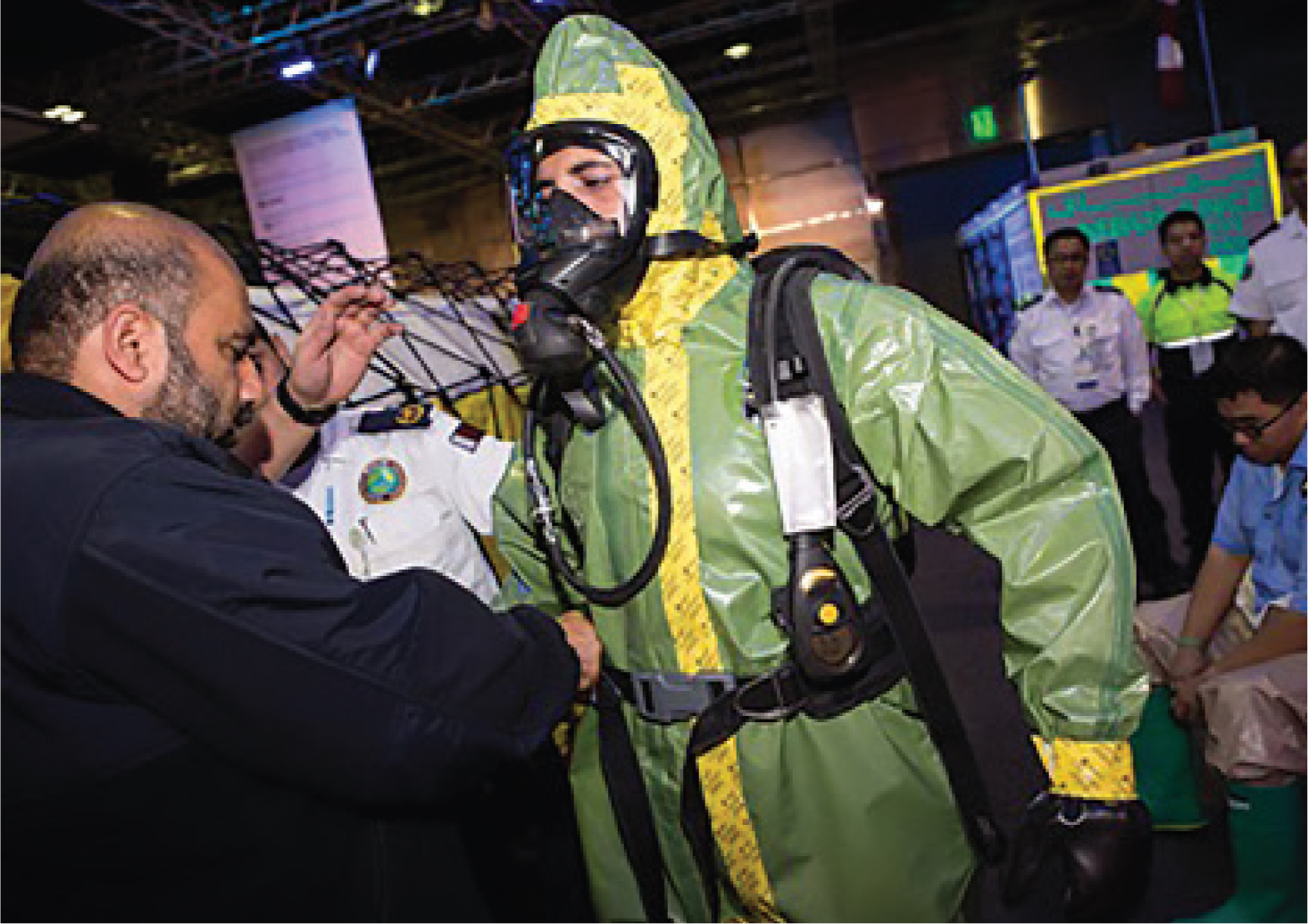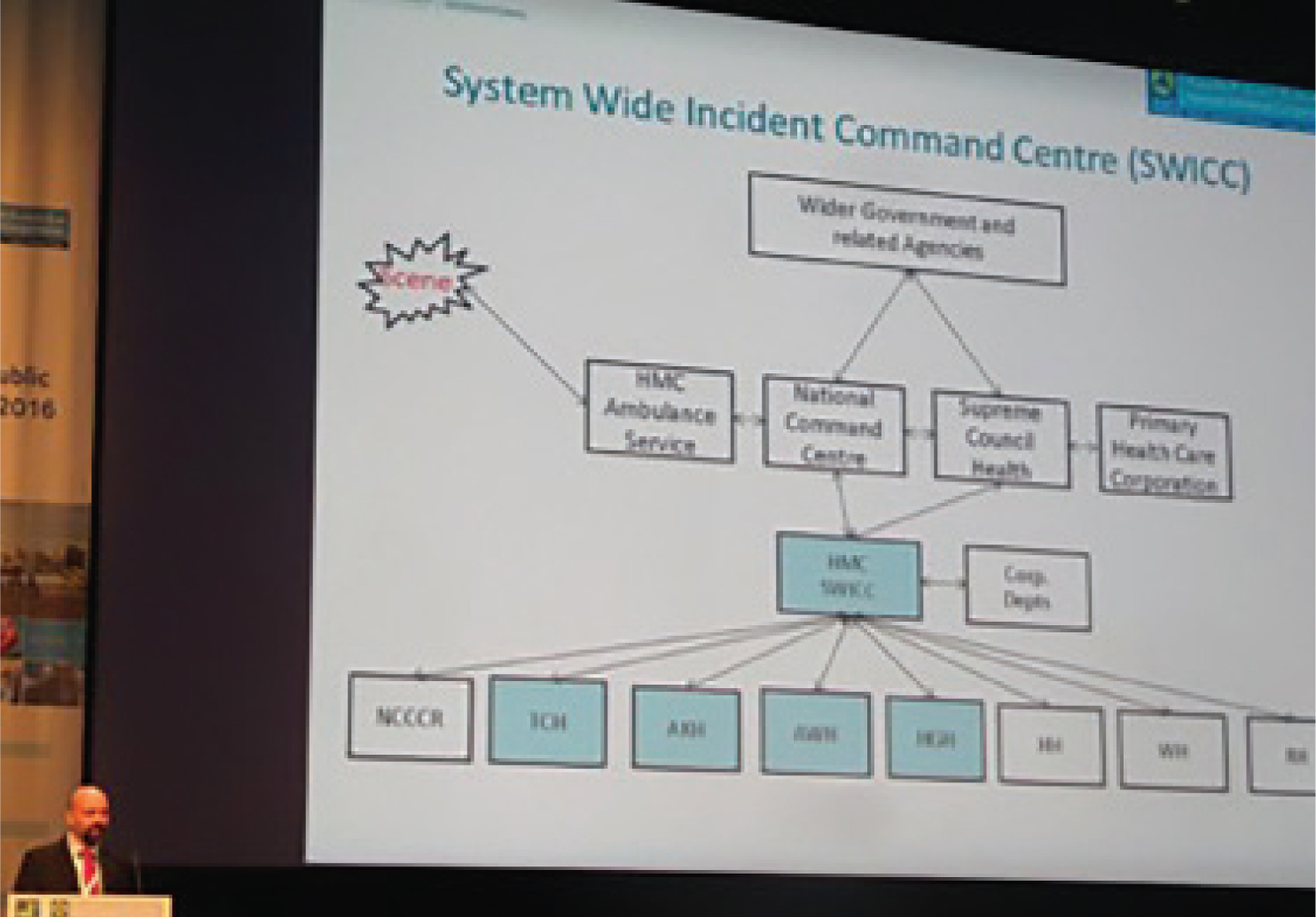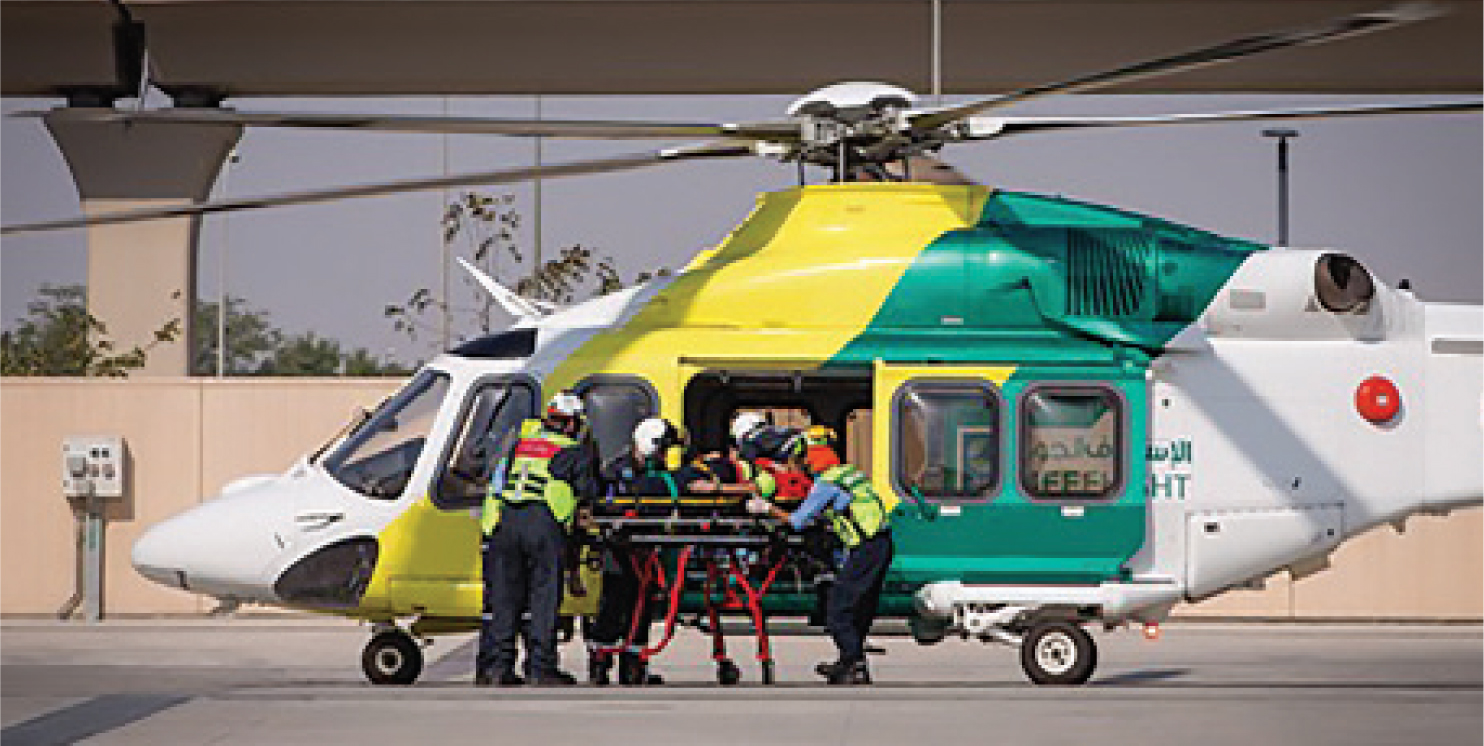In recent years, Emergency Medicine (EM) has emerged as an important specialty in addressing numerous public health concerns such as management of chronic conditions, injuries, emerging health risks, and the delivery of clinical and preventive services. In Qatar and many other parts of the world, the Emergency Department (ED) serves as a point of entry into the healthcare system for a large percentage of the population. EDs often serve as potential sites of surveillance for various public health initiatives. Public health aims to prevent disease and their spread, promote health, and prolong life expectancy among the population as a whole. The critical interface between EM and Public Heath has been recognized in the literature as an important measure of the overall care given to the community (Bernstein et al, 1994; Bernstein and Haukoos, 2008). Both public health and EM serve as important partners for pre-hospital and paramedic practice in order to deliver the best patient care. Key aspects under consideration to minimise risks to patients or casualties are effective communication at various levels (Manoj and Baker, 2007; Shah et al, 2016) and well thought through disaster response plans (der Heide, 2006; Rawls and Turnquist, 2010).
The International Conference in Emergency Medicine and Public Health – Qatar (ICEP-Q, www.hamad.qa/EN/All-Events/EMC5/Pages/default.aspx) 2016 conference was undertaken as a collaborative effort to endorse the above key concepts in the interface between EM and Public Health. The conference was jointly hosted by Hamad Medical Corporation, the largest provider of healthcare services in Qatar, and the Supreme Council of Health (since then transformed into the Ministry of Public Heath – MoPH), the overarching supervisory health care body with responsibility for all of Health Care in Qatar. The conference was supported by various partners, including the Hamad Medical Corporation Ambulance Service (HMCAS) that have the responsibility to provide pre-hospital care to the entire population of Qatar. The event was conducted over 5 days (14–18 January 2016), with the first two days consisting of pre-conference workshops held at various academic venues in Qatar and the subsequent three days at the prestigious Qatar National Convention Centre (QNCC). The main conference program comprised parallel scientific sessions, free paper presentations, and skills workshops. The conference received several endorsements from prominent bodies in EM and Public Health – notably the International Federation for Emergency Medicine (IFEM, www.ifem.cc/), European Society For Emergency Medicine (EuSEM, http://eusem.org/), African Federation for Emergency Medicine (AFEM, www.afem.info/), World Association for Disaster and Emergency Medicine (WADEM, https://wadem.org/), American Academy of Emergency Medicine (AAEM, www.aaem.org/), Mediterranean Academy of Emergency Medicine (MAEM), and The Eastern Mediterranean Public Health Network (EMPHNET, http://emphnet.net/). In this brief report, we attempt to highlight key themes from the ICEPQ-2016 conference with relevance to paramedic practice and serve future academic activities.
Pre-conference workshop activities
The scientific committee planned the pre-conference workshops to be of relevance to a wide audience consisting of a variety of practitioners in EM, Public Health, and pre-hospital practice. Of specific relevance to paramedic practice were hands-on workshops in the following areas:

The conference scientific contents
The conference programme contained invited talks as well as abstracts received for oral and poster presentations. The call for abstracts was broadly divided among the following tracks:
A total of 164 abstracts were presented by international authors in the form of moderated poster sessions and oral presentations. All abstracts were published online in the open access Journal of Emergency Medicine, Trauma and Acute Care (JEMTAC, 2016). The main pre-hospital or ambulance services related abstracts are listed in Table 1.
| 1. Alinier G, Meyer J, Hutton D, Farhat H, Bayoumy A, Gonzales E, Ragbheer S, Singh K, Aguila N, El-Khady M, Al Yazidi K, Campbell C, Al-Bakri A. Raising awareness about driving safety in an ambulance service. Journal of Emergency Medicine, Trauma and Acute Care: Vol. 2016, Special issue of International Conference in Emergency Medicine and Public Health: Qatar, 21 |
| 2. Alenazi SK, Al-Otaibi BS, Alenaz AN, Alrashidi QS. Stress and burnout among Red Crescent paramedic ambulance workers in Riyadh. Journal of Emergency Medicine, Trauma and Acute Care: Vol. 2016, Special issue of International Conference in Emergency Medicine and Public Health: Qatar, 67 |
| 3. Alinier G, Mraidi R, Hamzaoui M, Vincent F, Naidoo V, Meyer J, Singh K, Dipalac J, Sevanesan P, Al Badawi A, Mahmoud M, Aguba J, Balan V, Zarrougui C, Narido J. Sustainment of a weekly OSCE with new staff in an Ambulance Paramedic Training Department. Journal of Emergency Medicine, Trauma and Acute Care: Vol. 2016, Special issue of International Conference in Emergency Medicine and Public Health: Qatar, 80 |
| 4. Campbell C, Al Shaikh L, Saifeldeen K, Bowen J, Pap R, Alinier G, Meyer J, Naidoo V. Validation of the pre-hospital Qatar Early Warning Score (QEWS) to determine transport priority. Journal of Emergency Medicine, Trauma and Acute Care: Vol. 2016, Special issue of International Conference in Emergency Medicine and Public Health: Qatar, 104 |
| 5. Jundi I, Abujaber A, Alinier G, Campbell C, Meyer J, Al Shaikh L, Cameron P, Rull S, Kamel H, Govender K. Qatar ambulance service and Hamad General Hospital Emergency Department staff's perception of current patient handover practice. Journal of Emergency Medicine, Trauma and Acute Care: Vol. 2016, Special issue of International Conference in Emergency Medicine and Public Health: Qatar, 105 |
| 6. Hutton D, Alinier G, Meyer J. Optimizing the patient compartment design of ambulances in Qatar. Journal of Emergency Medicine, Trauma and Acute Care: Vol. 2016, Special issue of International Conference in Emergency Medicine and Public Health: Qatar, 106 |
| 7. Kamel H, Alinier G, Morris BD, Al Shaikh L, Cameron PA. One year exploring Qatar's ambulance service: Views from an Emergency Medicine Fellow. Journal of Emergency Medicine, Trauma and Acute Care: Vol. 2016, Special issue of International Conference in Emergency Medicine and Public Health: Qatar, 139 |
| 8. Kamel H, Osman H, Mohamed J, Mishreky L, Jundi IA. Concordance of diagnosis between the ambulance services and emergency departments. Journal of Emergency Medicine, Trauma and Acute Care: Vol. 2016, Special issue of International Conference in Emergency Medicine and Public Health: Qatar, 144 |
| 9. Alshorman SS, Almuhiarat AM, de Bruyn P, Khenissi M, Pullian N. Hamad Medical Corporation (HMC) ambulance service major incident response guide. Journal of Emergency Medicine, Trauma and Acute Care: Vol. 2016, Special issue of International Conference in Emergency Medicine and Public Health: Qatar, 156 |
The scientific programme
The three days of the scientific programme included keynote addresses on the first day by Qatar's Director of Public Health, MoPH, Sheik Dr Mohammed Al Thani (“Preventive Healthcare – Achievements and Challenges”), by Dr Teri Reynolds, a scientist from the World Health Organization (“The Interface between Emergency Medicine and Public Health: The WHO Emergency Care Program”), by Dr Mohammed Al Hajri (Consultant in community medicine, MoPH), who gave a keynote lecture on “Unveiling National Disaster Plan-Emergency Preparedness and Response in Health Sectors”, by Prof Della Corte (Università del Piemonte Orientale and Maggiore Hospital School of Medicine, Milan, Italy) who spoke about “Simulation in Training Professionals for Mass Casualty Incidents and Disaster Response” and Ms Heather McClelland (Nurse Consultant in Calderdale and Huddersfield in West Yorkshire, UK) on “Public health and Emergency Medicine Partnership in Disaster Management”. It also featured parallel tracks on Emergency Imaging and point of care ultrasound (POCUS), Infectious Diseases and Public Health, Emergency Toxicology and CBRNE, Emergency Nursing, Major Emergency Management in Health Sectors, Trauma, and injury Prevention, as well as free paper presentations on Pre-Hospital and Emergency Medical Services (Table 1). A presentation entitled “Managing an Acute Health System‘s Response to Major Incidents” highlighted the recent extensive work conducted in Qatar with regards to emergency preparedness across the complete healthcare system (Figure 2).

The second day included another Free Paper Presentation session on Disaster, Environmental and Major Emergencies, and Quality Improvement, as well as other parallel tracks on Public Safety and Health Promotion, Emergency Department Critical Care, Communicable Diseases and Emergency Medicine, Road Safety, Emergency Department Critical Care, Public Health Emergency Risk Management, Health in Populations at Risk, Interprofessional Education, Occupational health, EMS, Pre-Hospital Medicine and Disasters, some of which were run by a group of speakers from the WHO Communicable Diseases and Emergency Medicine. Keynote lectures were delivered by Prof Tim Harris (Barts Health NHS Trust, London, UK) on “Updates in Critical Care”, by Professor Andy Jagoda (Icahn School of Medicine at Mount Sinai, New York City, USA) on ‘Practice Guideline Development and Implementation’, by Dr Carl Rikard Moen (Royal College Physicians, London, UK) on “Presentations of Occupational Health to in the Emergency Room”, and by Mr. Bill Justice (University of Oklahoma, USA) about “Bringing Battlefield Medicine to our Streets”. A limited numbers of pre-registered delegates also had an opportunity to attend a workshop on Peripheral Access in a Challenging Patient – Learning New Standards of Practice.
On day three, Mr Robert Moorhead (Director, National Health Strategy Program Management Office, MoPH) took to the stage to deliver the Keynote on ‘National Health Strategy Qatar – Transforming Health’ and was followed by Mr Sven Byl (EY's Healthcare and Life Sciences Advisory Practice, USA) who spoke about “Qatar National Public Health Strategy”. Two parallel tracks on Health on Complex Emergencies and Clinical operations, informatics and Quality Improvement also took place.
Exhibit and demonstration of patient retrieval capabilities of the HMCAS
Of special note, during the three days of the scientific programme, was the extensive display set up by HMC Ambulance Service with vehicles of various sizes from the bike, airport Segway, golf cart ambulances, triage tents, all the way to the Mass Casualty Incident (MCI) trucks and containers providing Major Incident Response (MIR) capacity to various situations requiring triage shelters, generators, solar panels, lighting, or equipment for hazardous material incidents requiring special personal protective equipment (PPE), levels A to D suits (Figure 1), and decontamination showers. The exhibits drew huge crowds of delegates who were excited to view such equipment at close quarters as well as demonstrations. During the course of the conference, delegates had an opportunity to witness a scheduled landing and take-off of HMC Ambulance Service's AW139 Life Flight helicopter (Figure 3). The demonstration took place at QNCC with live commentary about the landing zone preparation, the approach, and vehicle and people movement around the aircraft. Delegates had an opportunity to see how a patient is transferred into, and unloaded from, the aircraft. All delegates appreciated the opportunity to witness such an exercise live, in close but safe proximity.

Summary
The conference was an unprecedented success with overwhelmingly positive feedback and had a wide attendance from over 1,600 delegates representing 31 countries, and included around 100 pre-hospital care professionals. Most of the delegates expressed interest in future editions of this first of its kind conference in Emergency Medicine and Public Health in Qatar. The outcomes from this conference serve as a reminder for the pre-hospital and paramedic community to be aware of this emerging interface. This collaborative conference is envisaged as the beginning of many such endeavours which will look to focus on Qatar‘s National Vision 2030 to enable the development of a prosperous society.

